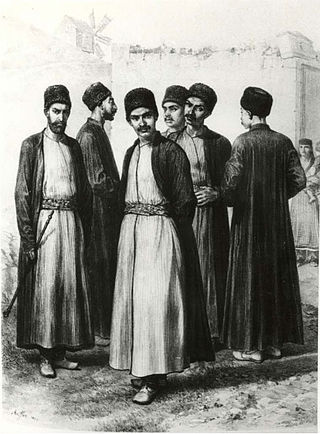
Judaism is an Abrahamic, monotheistic, and ethnic religion that comprises the collective spiritual, cultural, and legal traditions of the Jewish people. Judaism evolved from Yahwism, an ancient Semitic religion of the late Bronze Age to early Iron Age, likely around the 6th/5th century BCE. Along with Samaritanism, to which it is closely related, Judaism is one of the two oldest Abrahamic religions.
The relationships between the various denominations of Judaism are complex and include a range of trends from the conciliatory and welcoming to hostile and antagonistic.
Jewish religious movements, sometimes called "denominations", include diverse groups within Judaism which have developed among Jews from ancient times. Today in the west, the most prominent divisions are between traditionalist Orthodox movements and modernist movements such as Reform Judaism originating in late 18th century Europe, Conservative originating in 19th century Europe, and other smaller ones, including the Reconstructionist and Renewal movements which emerged later in the 20th century in the United States.
Karaite Judaism is a Jewish religious movement characterized by the recognition of the written Tanakh alone as its supreme authority in halakha and theology. Karaites believe that all of the divine commandments which were handed down to Moses by God were recorded in the written Torah without any additional Oral Law or explanation. Unlike mainstream Rabbinic Judaism, which regards the Oral Torah, codified in the Talmud and subsequent works, as authoritative interpretations of the Torah, Karaite Jews do not treat the written collections of the oral tradition in the Midrash or the Talmud as binding.

Conversion to Judaism is the process by which non-Jews adopt the Jewish religion and become members of the Jewish ethnoreligious community. It thus resembles both conversion to other religions and naturalization. The procedure and requirements for conversion depend on the sponsoring denomination. Furthermore, a conversion done in accordance with one Jewish denomination is not a guarantee of recognition by another denomination. Normally, though not always, the conversions performed by more stringent denominations are recognized by less stringent ones, but not the other way around. A formal conversion is also sometimes undertaken by individuals whose Jewish ancestry is questioned or uncertain, even if they were raised Jewish, but may not actually be considered Jews according to traditional Jewish law.

African Jewish communities include:
"Who is a Jew?" is a basic question about Jewish identity and considerations of Jewish self-identification. The question pertains to ideas about Jewish personhood, which have cultural, ethnic, religious, political, genealogical, and personal dimensions. Orthodox Judaism and Conservative Judaism follow Jewish law (Halakha), deeming people to be Jewish if their mothers are Jewish or if they underwent a halakhic conversion. Reform Judaism and Reconstructionist Judaism accept both matrilineal and patrilineal descent as well as conversion. Karaite Judaism predominantly follows patrilineal descent as well as conversion.
Schisms among the Jews are cultural as well as religious. They have happened as a product of historical accident, geography, and theology.
The Krymchaks are Jewish ethno-religious communities of Crimea derived from Turkic-speaking adherents of Rabbinic Judaism. They have historically lived in close proximity to the Crimean Karaites, who follow Karaite Judaism.

The Crimean Karaites or Krymkaraylar, also known as Karaims and Qarays, are an ethnicity of Turkic-speaking adherents of Karaite Judaism in Central and Eastern Europe, especially in the territory of the old Polish-Lithuanian Commonwealth and Crimea. "Karaim" is a Russian, Ukrainian, Belarusian, Polish and Lithuanian name for the community.

Egyptian Jews constitute both one of the oldest and one of the youngest Jewish communities in the world. The historic core of the Jewish community in Egypt mainly consisted of Egyptian Arabic speaking Rabbanites and Karaites. Though Egypt had its own community of Egyptian Jews, after the Jewish expulsion from Spain more Sephardi and Karaite Jews began to migrate to Egypt, and then their numbers increased significantly with the growth of trading prospects after the opening of the Suez Canal in 1869. As a result, Jews from many territories of the Ottoman Empire as well as Italy and Greece started to settle in the main cities of Egypt, where they thrived. The Ashkenazi community, mainly confined to Cairo's Darb al-Barabira quarter, began to arrive in the aftermath of the waves of pogroms that hit Europe in the latter part of the 19th century.
Religion in Israel is manifested primarily in Judaism, the ethnic religion of the Jewish people. The State of Israel declares itself as a "Jewish and democratic state" and is the only country in the world with a Jewish-majority population. Other faiths in the country include Islam, Christianity and the religion of the Druze people. Religion plays a central role in national and civil life, and almost all Israeli citizens are automatically registered as members of the state's 14 official religious communities, which exercise control over several matters of personal status, especially marriage. These recognized communities are Orthodox Judaism, Islam, the Druze faith, the Catholic Church, Greek Orthodox Church, Syriac Orthodox Church, Armenian Apostolic Church, Anglicanism, and the Baháʼí Faith.

Subbotniks is a common name for adherents of Russian religious movements that split from Sabbatarian sects in the late 18th century.
Meir Yosef Rekhavi is a British born Karaite Hakham and author.
In modern Rabbinic Judaism, the traditional method of determining Jewishness relies on tracing one's maternal line. According to halakha, the recognition of someone as fully Jewish requires them to have been born to a Jewish mother. A person who is born to a non-Jewish mother and a Jewish father is regarded as Zera Yisrael and will only be accepted as ethnically Jewish and not as religiously Jewish. Thus, being Jewish through the paternal line typically necessitates conversion to Judaism to validate one's identity as a Jew in the fullest sense.
Ira Nowinski is a photographer. Nowinski earned a Master of Fine Art's degree from the San Francisco Art Institute in 1973. From the late 1970s through the early 1980s, Nowinski served as the official photographer of the San Francisco Opera. His photographs have been collected extensively by the University of California, Berkeley's Bancroft Library; Stanford University Libraries' Department of Special Collections; Bibliothèque Nationale in Paris; the Museum of Modern Art, New York, and the National Museum of Photography, Bradford, England.
Ḥakham Moshe ben Yoseph Firrouz is an Israeli Karaite Hakham and Torah scholar (sage). He is the former Chief Ḥakham as well as Registrar of Marriage and Divorce of Israel's traditional Karaite Jewish Community. He served as Chairman of the Council of Sages of World Karaite Judaism and its religious council. Though Karaites do not have Rabbis, he is considered a Rabbi for the purpose of accommodating the Israeli authorities.





